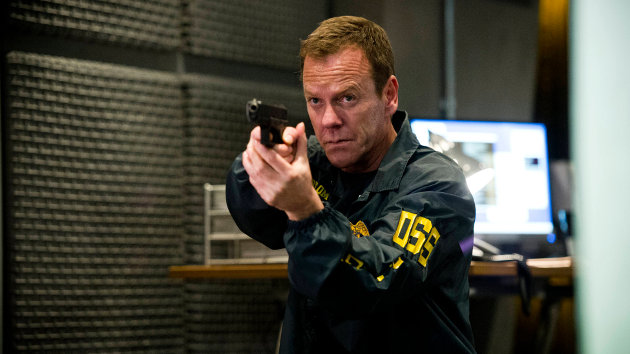Production and Post for What May (Still) Be the Most Intense 12 Hours on TV

The biggest surprise on 24 this year may just be that the show's really good. Yes, the Jack Bauer Power Hour really did run out of steam by the time it left the air in 2010. And, yes, there's plenty about 24: Live Another Day that feels overly familiar — there's a U.S. president who's not quite sure whether to trust Jack, there's a weasel on the president's staff who wants to betray Jack, and there's a woman who still seems to love him despite what he did to her back in season 8 — but when the show is on target, it fires on all cylinders. Last week's episode reached an explosive climax at Wembley Stadium, leading many fans to wonder: did 24 really go there? Well, we'll try not to spoil anything in case you're not caught up. You should be safe reading this recap of what we know about production and post on the show, which shot this year in London, based on information released today by 24 post facility Encore as well as various sources around the web.
This time, 24 turns to the ARRI Alexa. The biggest difference between the original series and this reboot is probably that 24 was always captured on 35mm film, but 24: Live Another Day is shot on the Alexa. According to post facility Encore, footage is mailny recorded in Log-C ProRes 422 (HQ). The Alexa footage is occasionally intercut with pick-up shots from GoPro and other B-camera units shooting AVCHD.
The new DP has been here all along. Cinematographer Jeffrey Mygatt, who takes over this year from longtime series DP Rodney Charters, ASC (lately busy with Dallas), has worked on 24 since its pilot, and he served as the show's cinematographer for several episodes in the series' fourth and sixth seasons. According to IMDb, his other credits include stints on Prison Break, Terra Nova, Touch, and Agents of S.H.I.E.L.D.
Budget watch: film stock. According to Charters, quoted in Noah Kadner's book Red: The Ultimate Guide to Using the Revolutionary Camera, the original 24 spent $4 million per season on Kodak film stock. Because Live Another Day is just 12 episodes, compared to the 24 episodes that made up a season of 24, the move to digital may eliminate a $2 million budget item.
Budget watch: tax incentives. By moving to London, 24 takes advantage of a new U.K. tax incentive introduced in 2013 that allows television productions spending more than £1m per hour to pick up a 20 percent tax rebate. "It's harder to fake London" than previous 24 settings like Washington, D.C., and New York City executive producer Howard Gordon said in an interview with Quartz. "Between that, tax breaks, and the fun of it, we said, 'Let's do it.'"
— Howard Gordon, quoted by
Quartz
Budget watch: the tech who wasn't there. The production studio has a no-DIT policy for TV programming, according to an interview with Mygatt at HD Video Pro. Instead, the DIT's tasks are offloaded onto the DP, who is expected to communicate all of his color choices clearly from set by providing stills that reflect the intended look.
Request denied: VFX. Encore Hollywood's VFX department apparently asked that the camera be locked-off when shooting action scenes to make it easier to place CG elements. Responded Mygatt, "No amount of after-the-fact shaking and zooming on the plate is going to match the credibility of what we do in the moment, so you're going to have to find a way to get your effects to work with the way we shoot. We can put in cardboard stand-ins and extra tracking markers to help you place your element … but we can't compromise the style."
Encore London handled the dailies. The show had four deliverable formats: Avid DNxHD 36 for editorial in London, a DVD disc image (.ISO) for production, QuickTime files for DP Jeffrey Mygatt to review on his iPad, and MP4 files distributed via the Dax platform. The DNxHD files were also sent to Encore Hollywood via Aspera Point to Point, which transfers files at up to 300 Mbps, and source material is archived to LTO-5 tapes that were shipped to Encore Hollywood.
Encore Hollywood handled the online. The show is conformed on an Avid Symphony at Encore Hollywood. Encore Senior Editor Heydar Adel matches the cuts to the high-resolution source footage, integrates VFX shots, and adds fixes and secondary effects like muzzle flashes using Adobe After Effects.
Color is complicated. Color-grading takes place on a Linux workstation running Blackmagic DaVinci Resolve. The show's split-screen sequences make the task a little more complex, since those scenes feature multiple edits on screen at the same time, meaning the different panels need individual, cut-by-cut attention within the overall frame. Encore Senior Colorist Kevin Kirwan takes about 12 to 13 hours to complete an episode before it's sent back to the Symphony suite, where Adel adds final titles and graphic elements, including the show's iconic countdown clock.
We're running out of time! If you liked the watches worn by some of the show's characters, you'll be able to buy one just like them in July, thanks to a deal struck between the producers and the U.S. Agency Watch Company. It's either a shrewd piece of marketing or the latest example of product placement run amuck, depending on your point of view. At any rate, the
CTU1 24Watch sells for a cool $249.



